HGST’s Ultrastar 7K4000 3.5″ form factor enterprise-class HDD now ranges up to 4TB in capacity and spins at 7,200RPM while interfacing over SATA 6Gb/s. The drive offers the enterprise a 33% capacity leap over previous models, and it accomplishes that task of delivering robust capacity by utilizing five platters at 800GB each to attain the maximum 4TB capacity. This is a huge feature for enterprise customers who need to maintain the same footprint for their drives without increasing their costs. Another significant feature on the Ultrastar 7K4000 is that it is offered in Advanced Format which uses a 4096-byte sector size that is still backward-compatible with the 512-byte sector size. The HGST 7K4000 drive also features 64MB of drive cache.
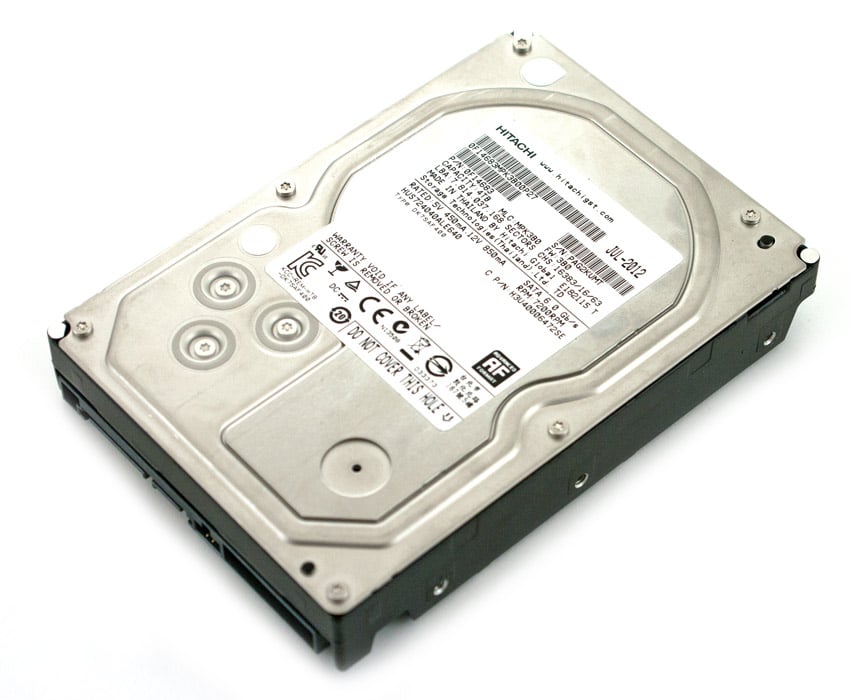
HGST quotes the Ultrastar 7K4000 with high endurance and low power consumption, and the drive is rated with a solid 2 million hour MTBF. Additionally, HGST says the drive’s five Advanced Power Management modes help the Ultrastar 7K4000 reduce power consumption; watts per GB has been reduced by 24% and the Ultrastar’s overall power usage can be reduced by up to 59% during low RPM idle mode. Further, the 7K4000 uses less than 2W during standby and sleep mode.
The HGST Ultrastar 7K4000 is currently available and HGST includes its industry-leading five year standard warranty. Our test model is the 4TB capacity drive.
HGST Ultrastar 7K4000 Specifications
- Capacities
- 4TB – HUS724040ALE640
- 3TB – HUS724030ALE640
- 2TB – HUS724020ALE640
- Interface – SATA 6Gb/s
- Form Factor – 3.5-inch
- Sector size – 512e
- Max. areal density (Gbits/sq. in) – 446
- Data buffer – 64MB
- Rotational speed (RPM) – 7200
- Sustained transfer rate (typical) – 171 MB/s
- Seek time (read, typical) – 8.0ms
- Error rate (non-recoverable, bits read) – 1 in 1015
- Load/unload cycles (at 40° C) – 600,000
- Targeted MTBF – 2 million hours
- Warranty – 5 years
- Acoustics Idle (Bels, typical) – 2.9
- Startup current (A, max) – 1.2 (+5V), 2.0 (+12V)
- Read/write (W) – 11.4
- Unload idle (W) – 5.7
- Weight (typical) – 690g
- Environmental (operating) ambient temperature – 5 to 60C
- Shock (half-sine wave 2 ms) – 70G
- Vibration, random (G RMS 5 to 500 Hz) – 0.67 (XYZ)
- Environmental (non-operating) Ambient temperature: -40 to 70C
- Shock (half-sine wave 1ms) – 300G
Design and Build
HGST’s enterprise hard drives tend toward a similar product design. In this case, the top of the Ultrastar 7K4000 houses the product information label which indicates the drive model, capacity, and RPM speed. The sides of the drive house the six mounting screws, three per side. Flipping the drive around, we can see the interface connectors.
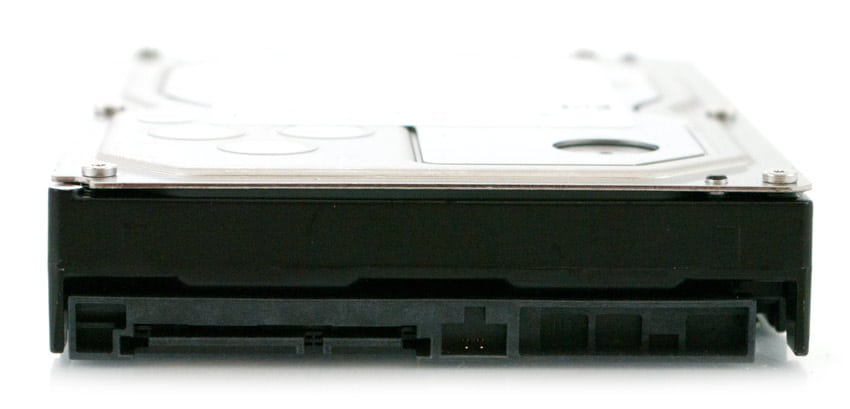
The HGST Ultrastar 7K4000 is a standard 3.5″ hard drive that utilizes SATA 6Gb/s. Aside from the silver metal top plate, the rest of the Ultrastar 7K4000 body is black. On the underside, users can remove the circuit board by removing 4 short screws and 2 longer screws. HGST has installed a foam pad between the drive and circuit board to help absorb vibrations.
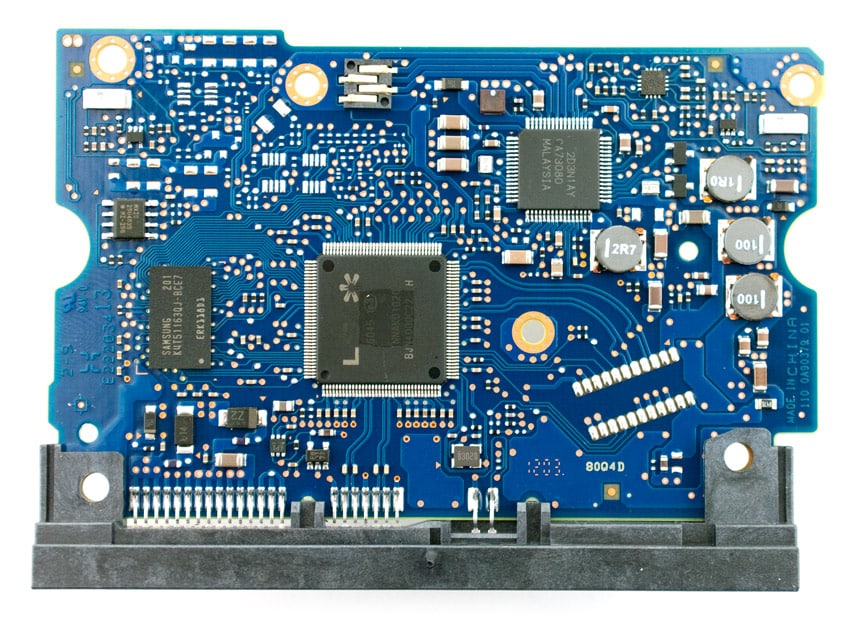
The circuit board includes an LSI TTNAK01320 controller chip, as well as 64MB of DRAM from the ESMT W14D5121532A module.
Testing Background and Comparables
7,200RPM Enterprise SAS HDD comparables for this review:
- Seagate Constellation ES.2 3TB
- 2TB Western Digital RE4
- 4TB Western Digital RE4
All enterprise HDDs are benchmarked on our enterprise testing platform based on a Lenovo ThinkServer RD240. The ThinkServer RD240 is configured with:
- 2 x Intel Xeon X5650 (2.66GHz, 12MB Cache)
- Windows Server 2008 Standard Edition R2 SP1 64-Bit and CentOS 6.2 64-Bit
- Intel 5500+ ICH10R Chipset
- Memory – 8GB (2 x 4GB) 1333Mhz DDR3 Registered RDIMMs
- LSI 9211 SAS/SATA 6.0Gb/s HBA
Enterprise Synthetic Workload Analysis
Our enterprise hard drive benchmark process preconditions each drive into steady-state with the same workload the device will be tested with under a heavy load of 16 threads with an outstanding queue of 16 per thread, and then tested in set intervals in multiple thread/queue depth profiles to show performance under light and heavy usage. Since hard drives reach their rated performance level very quickly, we only graph out the main sections of each test.
Preconditioning and Primary Steady-State Tests:
- Throughput (Read+Write IOPS Aggregate)
- Average Latency (Read+Write Latency Averaged Together)
- Max Latency (Peak Read or Write Latency)
- Latency Standard Deviation (Read+Write Standard Deviation Averaged Together)
Our Enterprise Synthetic Workload Analysis includes four profiles based on real-world tasks. These profiles have been developed to make it easier to compare to our past benchmarks as well as widely-published values such as max 4K read and write speed and 8K 70/30, which is commonly used for enterprise drives. We also included two legacy mixed workloads, the traditional File Server and Webserver, each offering a wide mix of transfer sizes.
- 4K
- 100% Read or 100% Write
- 100% 4K
- 8K 70/30
- 70% Read, 30% Write
- 100% 8K
- 128K
- 100% Read or 100% Write
- 100% 128K
- File Server
- 80% Read, 20% Write
- 10% 512b, 5% 1k, 5% 2k, 60% 4k, 2% 8k, 4% 16k, 4% 32k, 10% 64k
- Webserver
- 100% Read
- 22% 512b, 15% 1k, 8% 2k, 23% 4k, 15% 8k, 2% 16k, 6% 32k, 7% 64k, 1% 128k, 1% 512k
In our first workload with a 100% random 4K transfers, we measured 135 IOPS read from the Hitachi Ultrastar 7K4000 4TB and 185 IOPS write. This was comparable to the Seagate Constellation ES.2 3TB and just slightly less than the WD RE4 drives.
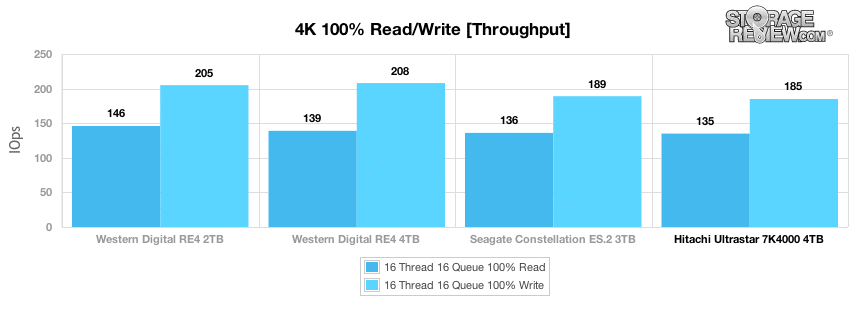
In our main average latency segment with a load of 16T/16Q, we measured an average read latency of 1875.52ms and a write latency of 1374.62ms from the Ultrastar 7K4000 which was just slightly more than the competitors.
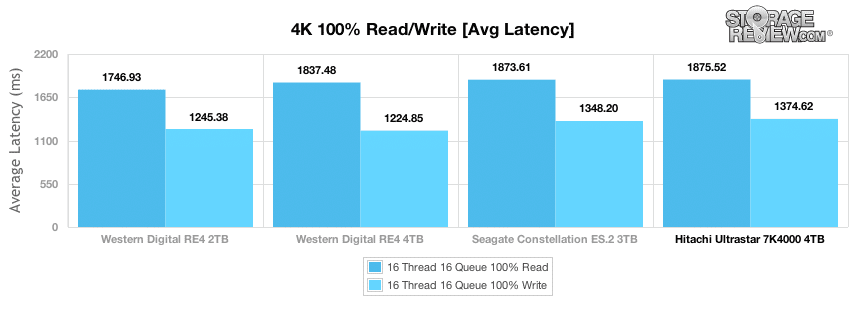
With just read activity, the Ultrastar 7K4000 had a max response time of 5099.0ms and the write activity max latency was 2942.0ms. That places the Ultrastar 7K4000 in the middle of the pack.
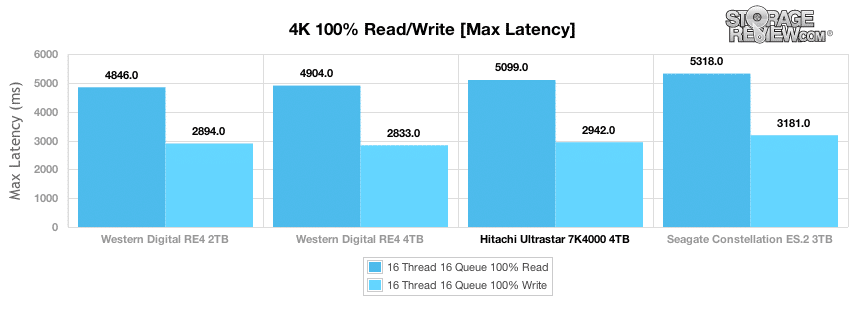
Reviewing the 4K latency consistency in our standard deviation section, the Hitachi Ultrastar 7K4000 tested at 514.62ms read standard deviation. It came in at 125.91ms write standard deviation.
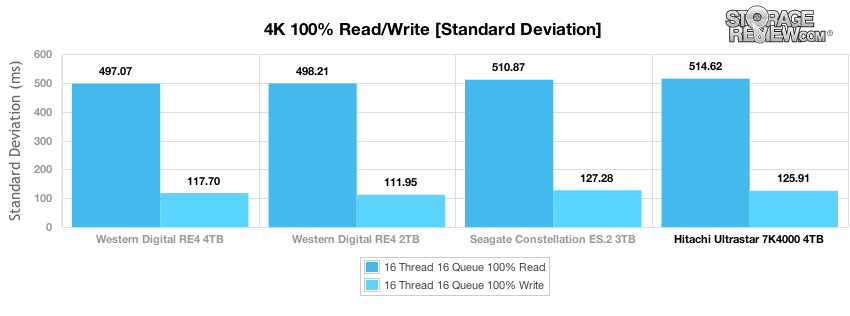
Compared to the fixed 16 thread, 16 queue max workload we performed in the 100% 4K write test, our mixed workload profiles scale the performance across a wide range of thread/queue combinations. In these tests, we span workload intensity from 2 threads and 2 queue up to 16 threads and 16 queue. In the expanded 8K 70/30 test, the Hitachi Ultrastar 7K4000 came in the middle of the pack throughout most of the test, with the Western Digital RE4 2TB leading most of the way.
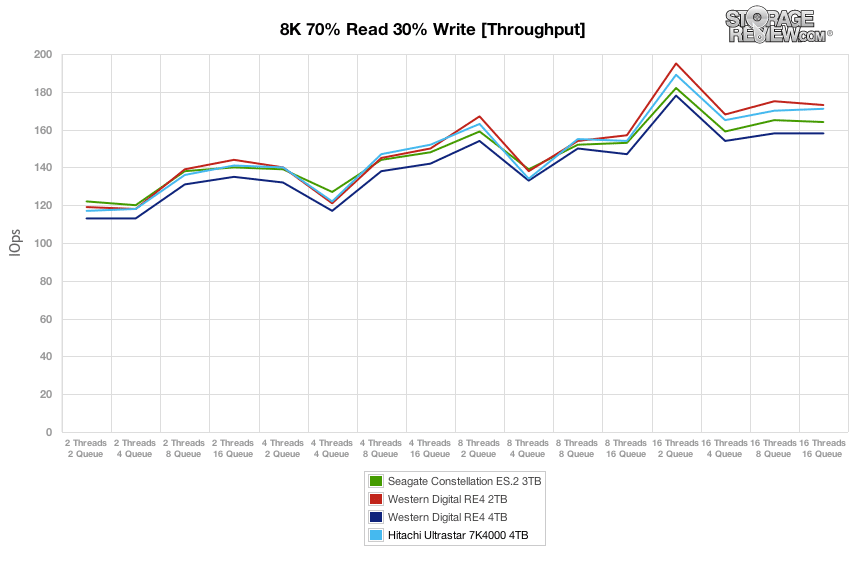
Examining the 8K 70/30 average response times, the Hitachi Ultrastar 7K4000 and the other drives all maintained a similar pace with the Hitachi and the WD RE4 2TB maintaining the lowest response times in the terminal queue depths.
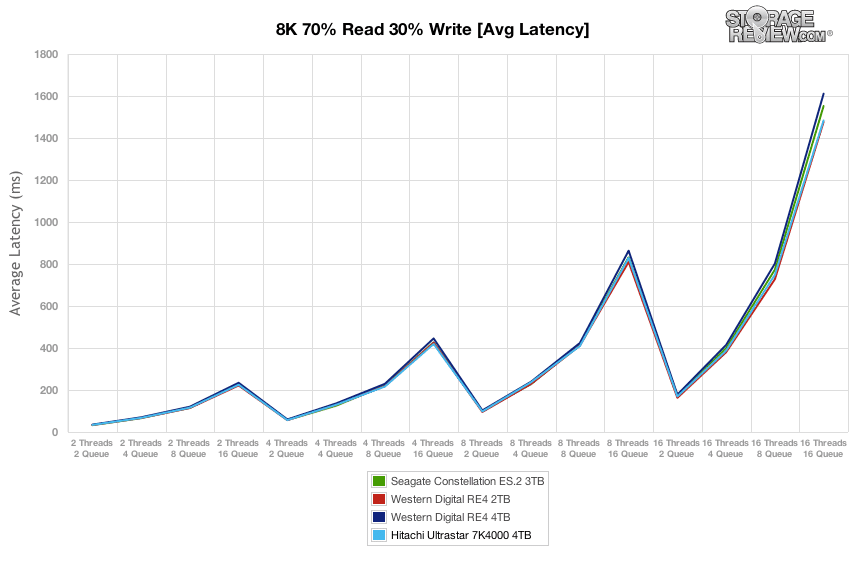
Over the duration of our primary tests at varying thread and queue depth levels, the Ultrastar 7K4000 has the second lowest max latency of 443ms at the 2 threads and 2 queue depth level. At the 16 thread and 16 queue depth level, the 7K4000 has the lowest max latency of 3,910ms. Throughout the tests, the Hitachi performed the best most of the time.
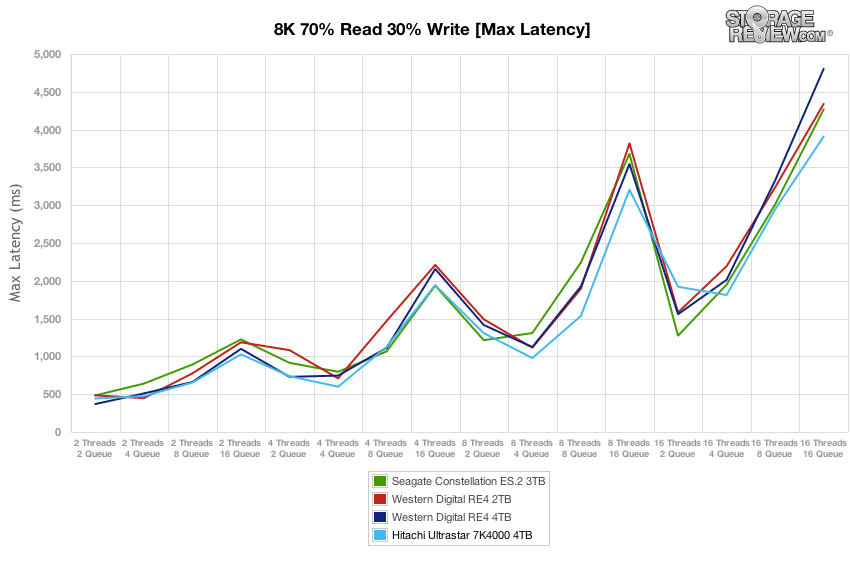
For the entire thread/queue spectrum, the Ultrastar 7K4000 maintained latency similar to the other two drives, edging them out again in the final stage.
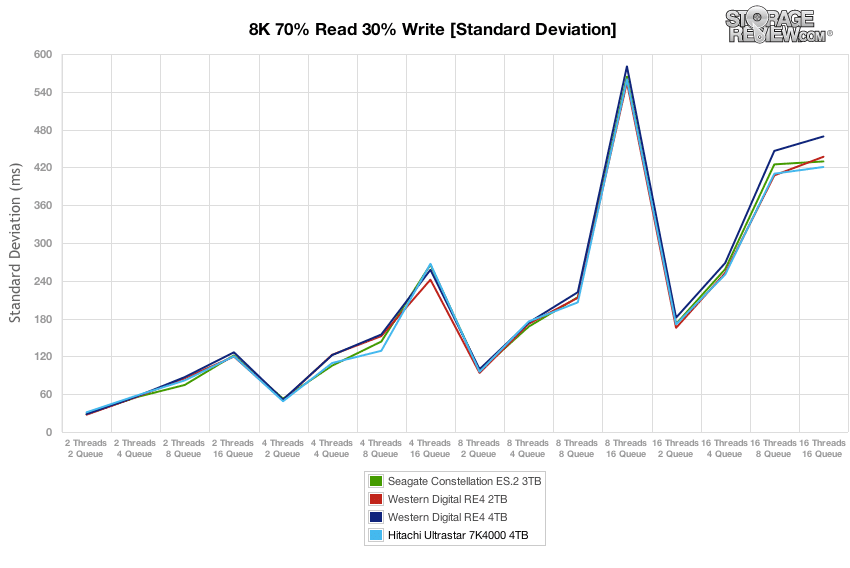
We have recently added a 128K test to our Enterprise Synthetic Workload. The test is a large block sequential test which shows the highest sequential transfer speed for a platter drive. Taking a look at 128K performance of 100% write and 100% read activity, the Ultrastar 7K4000 measured strongly at 166572 KB/s read and 166536 KB/s write, which were superior in both read and write activity.
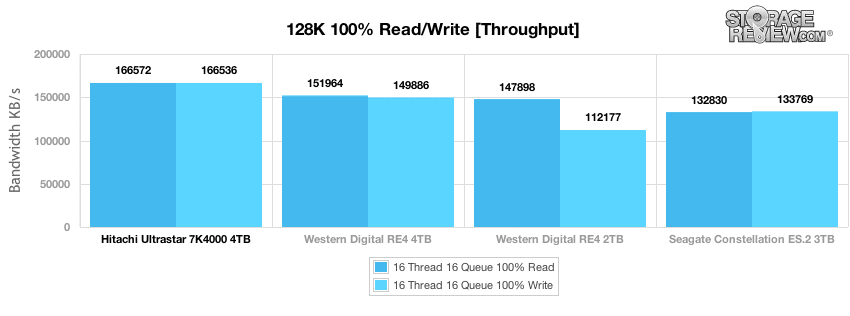
The next workload we used is our File Server profile which puts the drives through a varying workload. We scaled the thread and queue count from 2T/2Q up to 16T/16Q. In this profile, the Ultrastar 7K4000 ranked at the bottom of the pack.
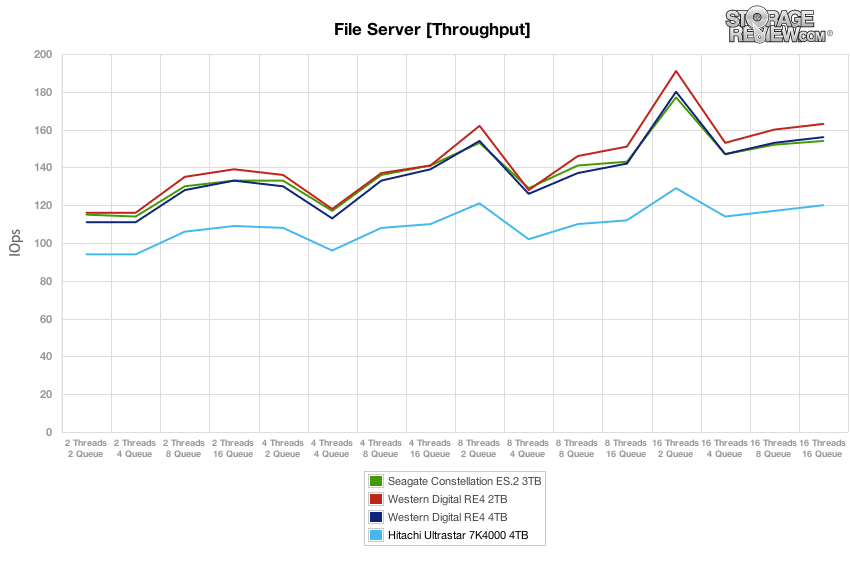
At all queue depths, the Ultrastar 7K4000 was higher than the rest of the drives in the pack. It peaked much higher at 2,121ms.
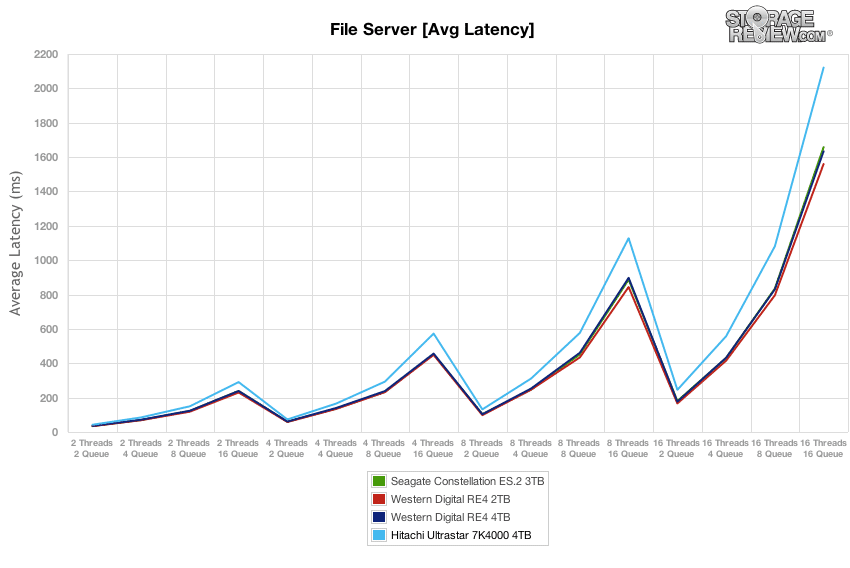
Comparing peak response times in our File Server profile, the Hitachi Ultrastar 7K4000 had several peaks that put its latency higher than the other drives in the pack.
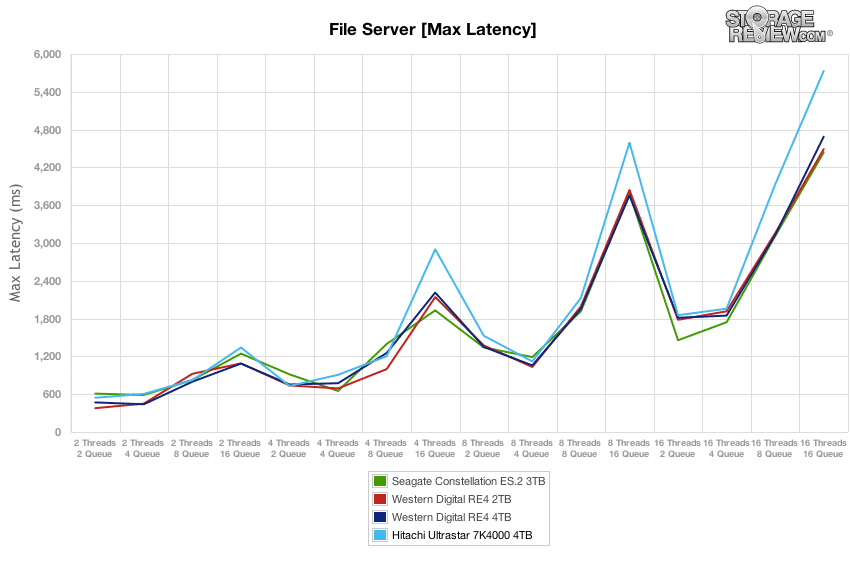
Looking at the latency standard deviation, the Ultrastar 7K4000 came in at the bottom of the pack in latency consistency.
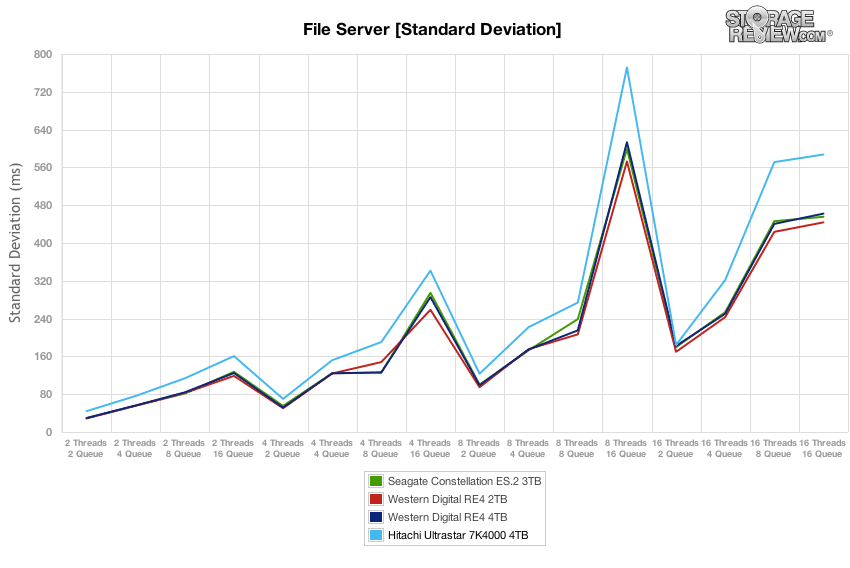
Our final test is the Web Server test, which is traditional 100% read activity. The Ultrastar 7K4000 performs at the bottom of the group most of the time, although it did have a middle of the pack peak around 16T2Q.
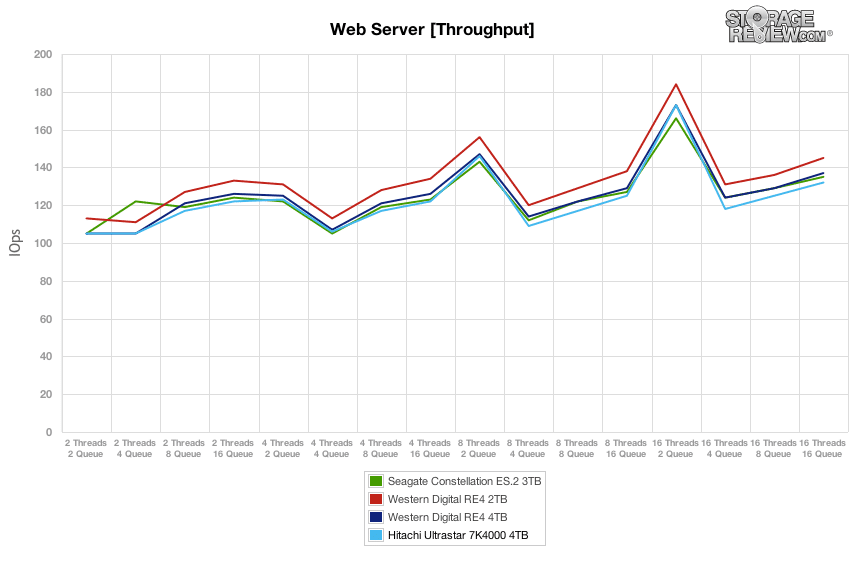
All drives performed competitively in our next test of average latency in the Web Server profile, though the Ultrastar 7K4000 was edged out.
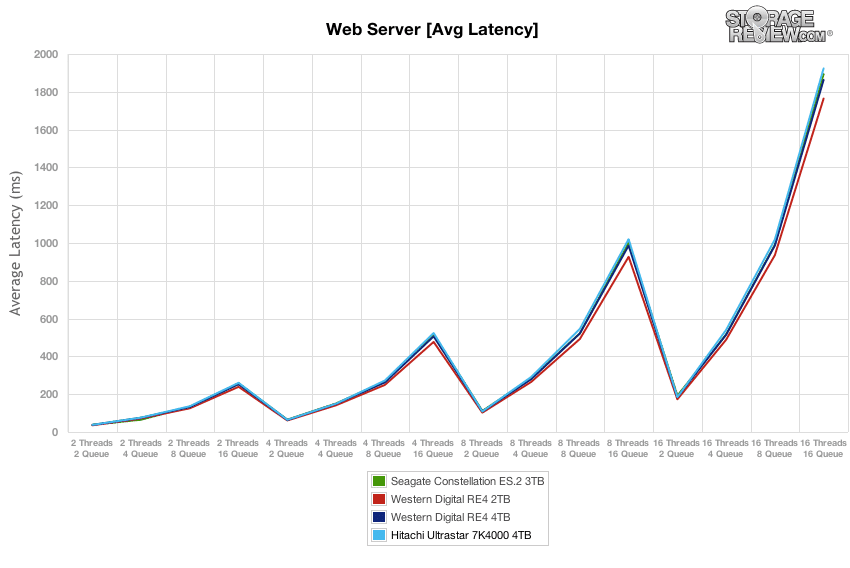
For the duration of the varying loads in our Web Server profile, the Ultrastar 7K4000 outpaced the other drives offering better latency. Starting at 8T16Q however, the Ultrastar 7K4000 started to fall behind the other drives.
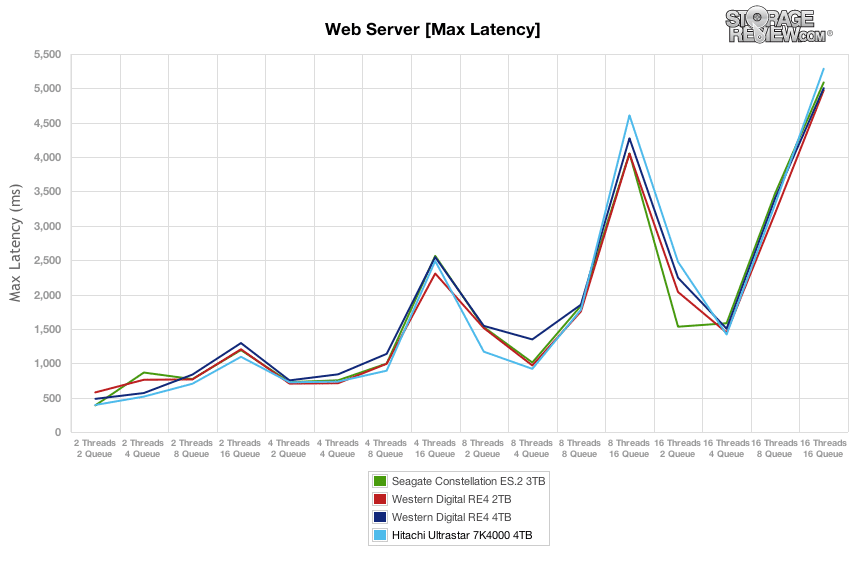
Comparing latency consistency in our read-only Web Server profile, the Hitachi Ultrastar 7K4000 performed at the bottom of the group by a small margin.
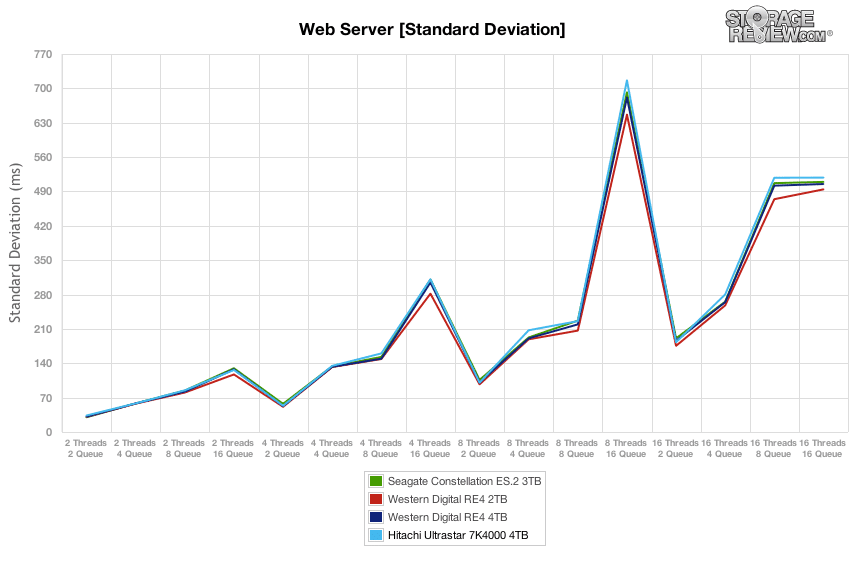
Conclusion
The HGST’s Ultrastar 7K4000 is an enterprise-class HDD that is now being offered in capacities up to 4TB (as in our 4TB test model) with a 3.5″ form factor. The drive also provides the enterprise with some high-end features. The drive spins at 7,200RPM, interfaces over SATA 6Gb/s, and is offered in Advanced Format using a 4096-byte sector size. The drive’s new 4TB maximum capacity provides users a 33% capacity boost over previous 3TB models by using five 800GB platters.
As we evaluated the HGST Ultrastar 7K4000 in our Enterprise Synthetic Workload test, the Ultrastar was competitive with the Seagate Constellation ES.2 3TB and 2TB and 4TB Western Digital RE4 drives. The Ultrastar performed very well in particular during our 128K sequential test that shows a best case scenario for hard drives. The drive also tested well in the 8K 70% Read/30% Write evaluation. On the other hand, the drive consistently had higher latency across the Web and File Server profiles and was also had lower performance in our random 4K tests.
On top of those features, the Ultrastar 7K4000 provides enterprise organizations with features that will be important to them. It offers high endurance and includes a 2 million hour MTBF, which is quite a bit higher than other drives on the market such as the 1.2 million hours offered by the WD RE 4TB. The 7K4000 is also rated to meet some significant power marks with overall power usage up to 59% lower during low RPM idle mode. These features along with the expanded capacity and maintained footprint make the drive attractive.
Pros
- High available capacity at 4TB
- 2 million hour MTBF
- Excellent Performance in 8K and 128K testing
Cons
- Weaker performance in Web and File Server Profiles
Bottom Line
The HGST enterprise-class Ultrastar 7K4000 offers high-end performance and robust capacity and is a logical upgrade for capacity-hungry applications.
Discuss This Review
Related Review – iXsystems Titan 316J JBOD Review with 16 HGST Ultrastar 7K400 HDDs




 Amazon
Amazon